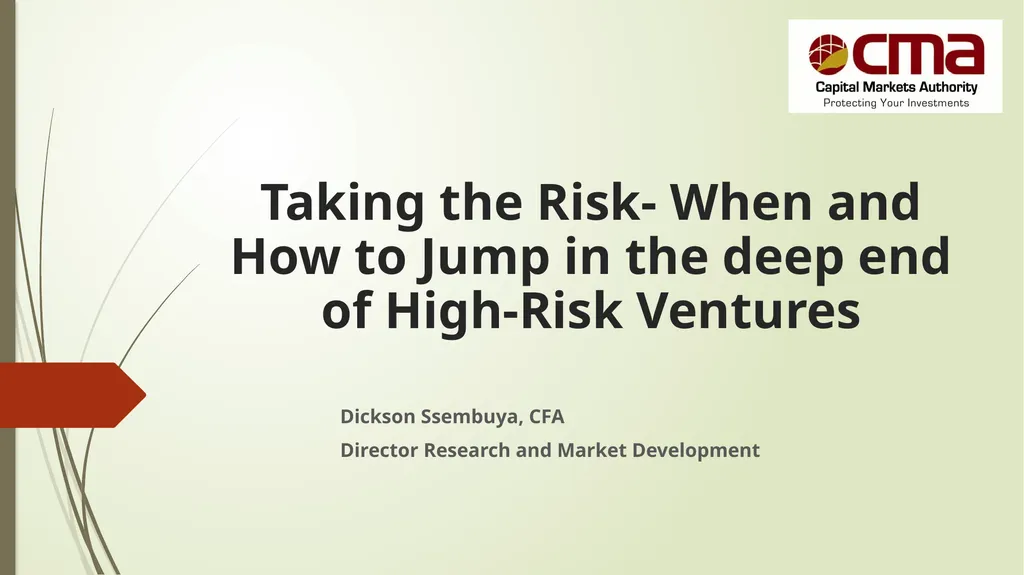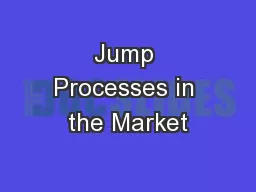Taking the Risk- When and How to Jump in the
Author : luanne-stotts | Published Date : 2025-06-27
Description: Taking the Risk When and How to Jump in the deep end of HighRisk Ventures Dickson Ssembuya CFA Director Research and Market Development Presentation Outline Background Key Considerations Before Investing Investor Types And Their Risk
Presentation Embed Code
Download Presentation
Download
Presentation The PPT/PDF document
"Taking the Risk- When and How to Jump in the" is the property of its rightful owner.
Permission is granted to download and print the materials on this website for personal, non-commercial use only,
and to display it on your personal computer provided you do not modify the materials and that you retain all
copyright notices contained in the materials. By downloading content from our website, you accept the terms of
this agreement.
Transcript:Taking the Risk- When and How to Jump in the:
Taking the Risk- When and How to Jump in the deep end of High-Risk Ventures Dickson Ssembuya, CFA Director Research and Market Development Presentation Outline Background Key Considerations Before Investing Investor Types And Their Risk Profile Importance of Understanding Personality Emotional bias in behavioral finance Strategies to Overcome Emotional Biases Why Understanding Investment Risks Is Important Importance of Getting Investment Advice Importance of Carrying Out Due Diligence Background Investing in high-risk ventures within capital markets can be both thrilling and daunting. It involves a delicate balance between the pursuit of substantial returns and the inherent uncertainties and volatility associated with high-risk assets. Understanding when and how capital markets investors should dive into the deep end of high-risk ventures requires a nuanced approach. After deciding how much risk is acceptable in a portfolio by acknowledging the time horizon and bankroll, one can use the investment pyramid approach for balancing their assets. The Investment Risk Pyramid Key Considerations Before Investing Risk Tolerance: Evaluate your comfort zone in taking on risk. Understand your willingness and ability to withstand potential investment losses, as high-risk ventures can lead to significant fluctuations in value and potential loss of capital. Financial Goals and Time Horizon: Consider your financial goals and investment time horizon. High-risk ventures may be suitable for long-term financial goals, but may not be appropriate for short-term objectives. Assess whether the potential returns align with your investment timeline Diversification: Understand the importance of diversification to reduce risk. Consider spreading investments across different asset classes and ventures to mitigate the impact of any single investment's performance on the overall portfolio Key Considerations Before Investing Cont’d Understanding the Investment: Fully comprehend the nature of the high-risk venture, including the underlying business model, market dynamics, and potential for returns. Thoroughly research the investment opportunity and assess its viability Exit Strategy: Evaluate the ease of exiting the investment. Understand the liquidity of the investment and the potential challenges associated with realizing returns from high-risk ventures Professional Advice: Consider seeking advice from financial professionals or investment advisors. Professional guidance can provide valuable insights and help assess the suitability of high-risk ventures based on individual financial circumstances and goals Investor Types And Their Risk Profile Cont’d Conservative Investors: These investors take low risks, focus on safe investments such as government bonds, fixed deposits, and debt funds, and prioritize stable returns over higher returns. They are risk-averse and prefer to invest in














